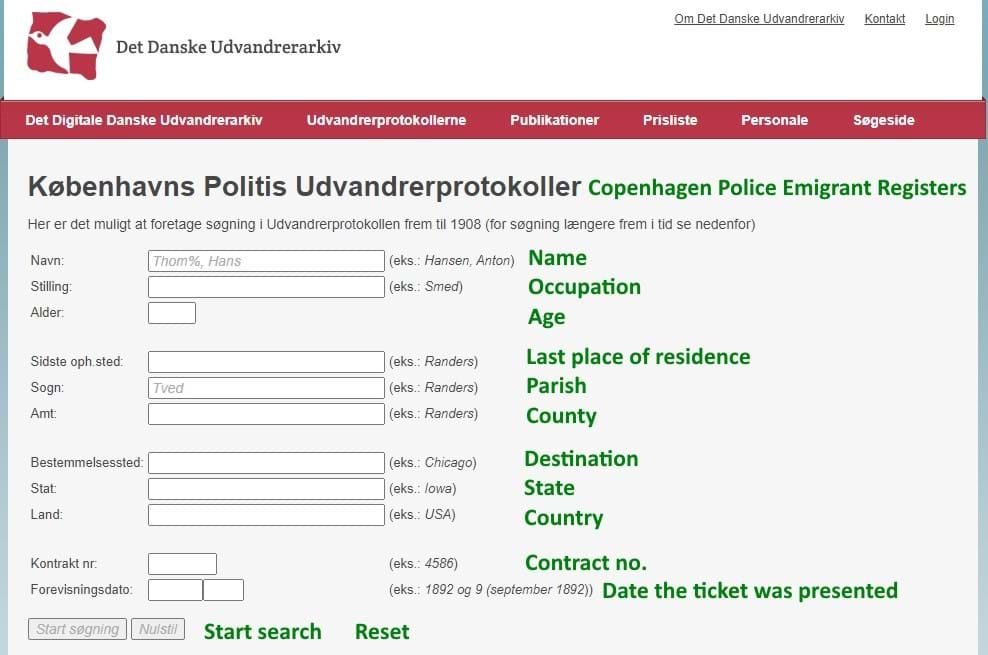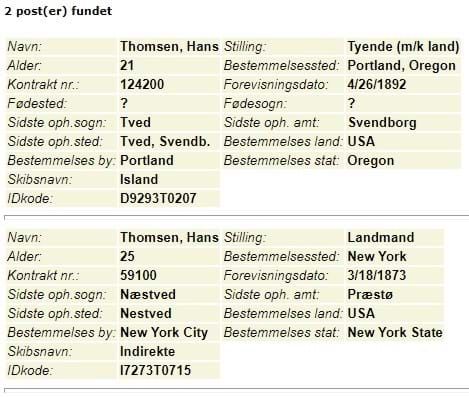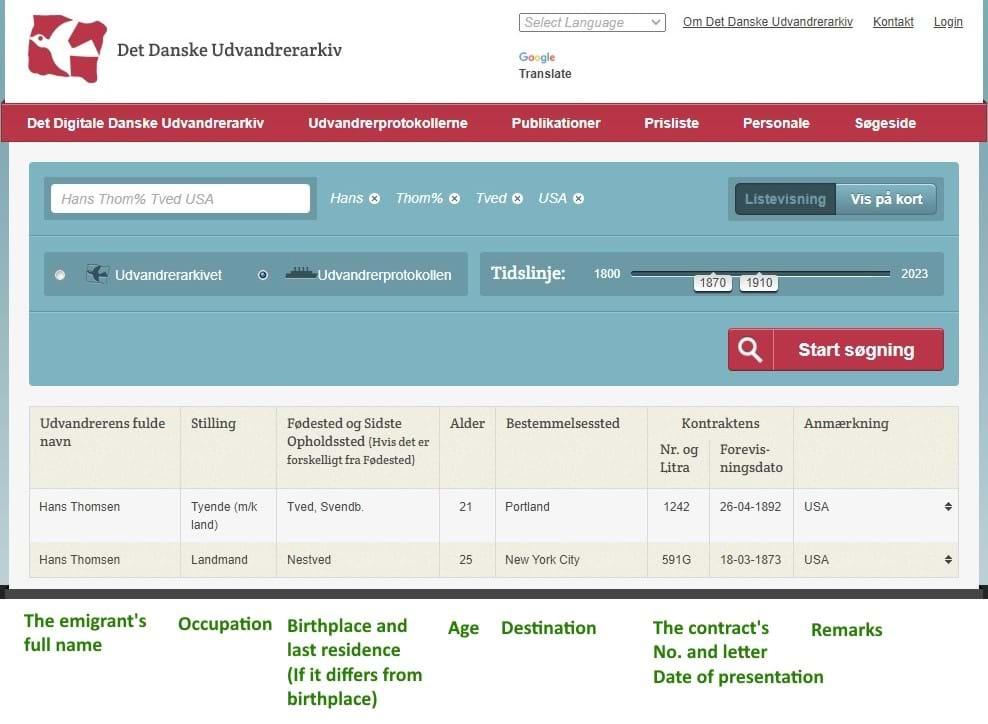The Danish Emigration Archives provides a free index of the Copenhagen Police Emigrant Registers from 1869 to 1913. There are two different search forms. In this blog post, I explain how to use them, and the caveats of each of them. I hope my tips will make it easier for you to find your Danish emigrant ancestor.
The Copenhagen Police Emigrant Registers
The Copenhagen Police kept the emigrant registers as a part of their audit of Danish travel agents from 1868 to 1952. The audit only covered overseas emigrants who bought a ticket from a Danish agent. In some cases, this means that your ancestor's emigration was not recorded by the Copenhagen Police.
A man may have emigrated on his own first and later bought tickets for the rest of the family from an agent in the United States. If the man bought his own ticket from a Danish agent, he should be listed, but the wife and children are not listed if their tickets were bought from a foreign agent. The same sometimes happened when a man emigrated and bought tickets for his brothers or sisters later.
Therefore, not all Danish emigrants are in the registers or the database. Anyhow, it's free to use, so why not give it a try?
Advanced Search Form: Index of Emigrants from 1869 to 1908
The advanced search form is available here: https://www.udvandrerarkivet.dk/udvandrerprotokollerne/
This search engine searches the index of the Copenhagen Police Emigrant Registers from 1869 to 1908. The advanced search form consists of twelve fields. I have added translations to the screenshot below.

Some things are good to know about this search form before you begin:
- The surname goes before the given names, separated by a comma.
- Danes can only have one surname. If your ancestor had two or more names that seem like surnames to you, it doesn't matter: In Denmark, only the last name counts as a surname. All other names, including middle names, are treated as given names.
- You can use the underscore character as a wildcard for one character.
- You can use the percentage sign as a wildcard for any number of characters.
- The search engine automatically adds the percentage sign wildcard to both ends of the search terms.
- You cannot request a precise search by adding quotation marks. The search engine's automatic use of the wildcard cannot be prevented.
- You cannot limit the search to a range of years of departure, only to one specific year.
Example 1: The Emigrant Hans Thomsen from Tved
Let's look at an example. I want to find Hans Thomsen, who was born on 10 May 1871 in Tved Parish, Svendborg County, and emigrated to the United States when he was in his early twenties.
Using the search terms shown in the screenshot above, I got two search results, as shown in the snippet below.

Most of the information should be understandable by looking at my translation of the search form above, but I have a few comments:
- Fødested and Fødesogn mean birthplace and birth parish.
- The date the contract was presented to the police is shown in the format month/day/year. That date was usually the day of departure or a couple of days before the departure.
- The system removes any letters from the contract number and adds two zeros to the end of the modified contract number.
- There was no ship named Indirekte, although that's what it says for the 25-year-old Hans Thomsen. Indirekte (indirectly) means that he did not sail from Copenhagen, but from a foreign port. Unfortunately, neither the ship name nor the port of departure was not recorded in the original register of indirect emigrants.
- The ID code (IDkode) is a reference to the original register. Understanding the ID code is helpful when you want to find the emigrant in the original register. For the 21-year-old Hans Thomsen the reference can be broken down as follows:
- D for the register of direct emigrants, meaning emigrants who sailed from Copenhagen.
- 9293 for the register for years 1892-93.
- T for the register's alphabet tab T.
- 02 for page 2.
- 07 for line 7.
Free-Form Text Search: Index of Emigrants from 1869 to 1913
The free-form text search is available here: http://www.udvandrerarkivet.dk/soegeside/
This search engine covers two different databases: Udvandrerarkivet (the Emigration Archives) and Udvandrerprotokollen (the Emigrant Register). By default, the Emigration Archives database is selected, so start by selecting the Emigrant Register.
This Emigrant Register database is an index of the Copenhagen Police Emigrant Registers from 1869 to 1913, meaning five years more than the other search form.
There is one search field only, so it ought to be simple, but unfortunately the algorithm has some non-explained rules that I have discovered through trial-and-error:
- Given names must go before surname.
- Search elements must follow the order of the fields in the other search form (see above), so for instance, last residence goes after name but before destination.
- You cannot use quotation marks to search for a specific combination of names.
- You can use the underscore character as a wildcard for one character.
- You can use the percentage sign as a wildcard for any number of characters both in given names, surnames, and place names – and it is possible to use more than one wildcard in the same search.
- As with the other form, the search engine automatically adds the percentage wildcard to both ends of all search terms, and that cannot be prevented.
Example 2: The Emigrant Hans Thomsen from Tved
Let's also use this search form to search for Hans Thomsen from Tved, but for this search I limited the search to a short range of years by moving the two sliders in the timeline. I limited it to 1870 to 1910. I could have limited it even more based on the information that Hans Thomsen emigrated when he was in his early twenties, but I want the other Hans Thomsen in the results for the purposes of this example.

The snippet above shows my search which provided two results. I have added translations of the headings. Clicking the tiny two-way arrow to the far right reveals the ship name, if the emigrant boarded the ship in Copenhagen. The result shows that Hans Thomsen from Tved emigrated on or about 26 April 1892 aboard the ship Island.
I have a few comments for these results:
- The search result does not provide the ID code. It's not a big deal, but having it makes it easier to find the emigrant in the original register.
- The search result provides the correct contract number. The 21-year-old Hans Thomsen traveled on contract number 1242 and the 25-year-old Hans Thomsen on contract number 591G. The exact contract numbers are useful when you want to find the emigrant in the original register.
- The date format on this page is day-month-year.
Never Trust an Index – Always Check the Original Record
I have only discovered a few transcription errors in this index, but still, I highly recommend checking the original register. Come back tomorrow to learn how to find an emigrant in images of the original registers from the Copenhagen Police.
Source References:
The image at the top of the post: Carl [Emil] Baagøe, "Udvandrerskibet 'Otttawa' forlader Kjøbenhavn paa dets første Reise til New-York" [The immigrant ship "Ottawa" leaves Copenhagen on its first trip to New York]; image, the Royal Danish Library, Digital collections (http://www5.kb.dk/images/billed/2010/okt/billeder/object398197/en?id=%2Fimages%2Fbilled%2F2010%2Fokt%2Fbilleder%2Fobject398197 : accessed 15 September 2023). It was reportedly painted or printed on 19 August 1866.




